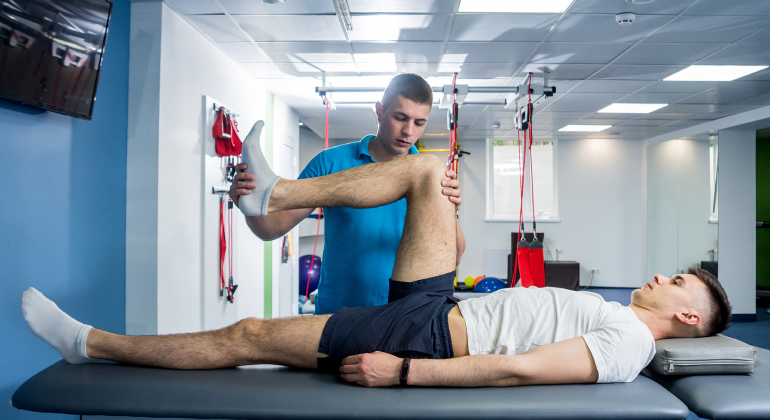Home physiotherapy has lately become somewhat popular in India largely due to improvements in the telehealth sector and other forms of virtual healthcare. Though technology offers many benefits, doctors and patients should also take into account the problems it raises. These advantages and disadvantages should guide your decisions on pain control and enable personal development. …
Home physiotherapy has lately become somewhat popular in India largely due to improvements in the telehealth sector and other forms of virtual healthcare. Though technology offers many benefits, doctors and patients should also take into account the problems it raises. These advantages and disadvantages should guide your decisions on pain control and enable personal development.
Pros of Home Physiotherapy

- Convenience and Accessibility – Home physiotherapy lets patients get treatment in the convenience of their own houses instead of having to travel to a clinic. Those who live in remote areas or find it difficult to travel would especially benefit from this. Home physiotherapy fills a major gap in healthcare in countries like India where rural areas lack access to the required tools. Setting meetings also helps one to better manage personal and professional obligations. Those who have a lot on their plates or who take care of others will particularly find this helpful.
- Personalized Care – Every patient can have an exercise program created by physiotherapists right in their own house. Usually more frequently than not, physiotherapists change exercises and routines to maximize space and resources, therefore enhancing their worth and effectiveness. Using everyday objects as makeshift training gear, for example, can enable one to be more relevant and fit for daily life. Personalized care also helps physiotherapists to take a more whole approach and thereby improve the efficacy of the treatment by providing advice on balance and daily activities.
- Comfort and Familiarity – Treating patients in familiar surroundings helps to lower the strain and anxiety linked with working in a hospital. The calmer and more eager to help patients produce better therapy results. This notably helps elderly people or those with anxiety. Moreover, familiar surroundings could improve a patient’s attitude and motivation, so helping them to follow their treatment advice more successfully.
- Enhanced Family Involvement – Increased family involvement gives family members more help and inspiration since it lets them easily assist with health care. This will enable people to follow their treatment plan and improve their general state. In countries where health and well-being depend on family support, this facilitates faster recovery. Family members can also learn how to help and support with activities, therefore turning treatment into a team effort.
- Continuity of Care – Home physiotherapy ensures that treatment never stops, which is particularly important for the management of long-term diseases. Regular virtual visits and monitoring support needed adjustments to the treatment plan and assist to sustain progress. This regular monitoring encourages ongoing development and helps to avoid mistakes. Under conditions like arthritis, it’s important to preserve control and change the treatment plan to help the patient to remain mobility and have less pain.
Cons of Home Physiotherapy

- Limited Equipment – While some homes might not have particular tools, clinics carry them. While many activities can be adjusted to suit your requirements, other therapies may demand materials or equipment not available in your residence. For example, ultrasonic therapy machines or highly advanced training equipment might not be readily accessible. Lack of instruments could limit the range of therapies and exercises available, thereby delaying the healing time for some conditions.
- Technical Challenges – Usually, home physiotherapy calls for consistent internet connection and understanding of how to use telehealth solutions. Remote meetings could not be as helpful since some participants might not be digitally competent. Older people who lack technological understanding or live in areas with sluggish internet can find this to be rather problematic. Technical issues can cause sessions to be cut off, thereby perhaps leading to insufficient guidance or omitted treatments.
- Less Hands-On Support – When you personally visit for physiotherapy, it can be fairly vital for the therapist to actively manipulate and change your body for some treatments. Remote conferences were unable to allow completion of these hand-made tasks. Some techniques, such soft tissue manipulations and joint mobilizations, are challenging to learn electronically. It can be challenging for a therapist who cannot feel anything to get a good sense of muscular tone and joint movement.
- Distractions at Home –Objects in the house could cause distractions during therapy sessions at home. Therapy sessions should take place in a quiet setting at a time when nobody else would be around. Distractions may be housework, dogs, and children. Especially in smaller houses or circumstances when individuals share living rooms, it could be challenging to locate a quiet area suitable for therapy.
- Not Suitable for All Conditions – Although home physiotherapy can treat many conditions, others need for specific clinical settings for the best treatment. Complicated situations still allow people to personally attend a clinic or hospital. Clinical settings enable the better control of illnesses needing advanced diagnostic tools or intensive rehabilitation tools. Following surgery or in severe cases of neurological illnesses may require more frequent personal adjustments and assessments.
Conclusion
Given its various advantages, many people find home physiotherapy to be a reasonable and personalized solution. Having said that, one should weigh these benefits against the probably negative ones. Knowing the benefits and disadvantages enables you to decide whether home physiotherapy is suitable for you. At Painflame, our aim is to satisfy the several needs of our patients using adaptable, efficient, all-encompassing physiotherapy sessions.
Recent Blog : How Physiotherapy work in pain
1. What is home physiotherapy and how does it work?
Home physiotherapy involves receiving physiotherapy treatments in the comfort of your home. Our expert physiotherapists tailor treatment plans to your specific needs and home environment. Through telehealth platforms, we provide real-time communication, progress tracking, and personalized adjustments to ensure you receive high-quality care remotely.
2. What conditions can be treated with home physiotherapy?
Home physiotherapy can effectively treat a wide range of conditions, including chronic pain, post-surgical recovery, sports injuries, arthritis, and neurological disorders. Our physiotherapists assess each patient’s condition to determine the most suitable treatment plan and ensure optimal care.
3. How do you ensure the effectiveness of home physiotherapy?
We use cutting-edge technology, including telehealth platforms and mobile apps, to provide comprehensive care. Our physiotherapists conduct regular virtual sessions, monitor progress, and adjust treatment plans as needed. We also offer guidance on exercises and techniques that can be performed safely at home, ensuring continuity and effectiveness of care.
4. What are the benefits of choosing home physiotherapy over traditional clinic visits?
Home physiotherapy offers several benefits, including convenience, personalized care, continuous monitoring, and comfort. Patients save time and costs associated with traveling to a clinic and can schedule sessions at their convenience. Additionally, receiving treatment in a familiar environment can reduce stress and anxiety, enhancing the overall effectiveness of the therapy.
5. How can family members support a patient undergoing home physiotherapy?
Family involvement is crucial in home physiotherapy. Family members can assist by providing emotional support, ensuring the patient adheres to the treatment plan, and helping with exercises if needed. We encourage family participation in therapy sessions to create a supportive environment that fosters better recovery outcomes.






